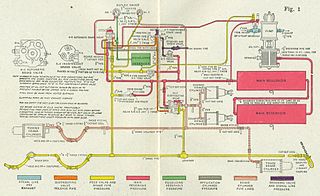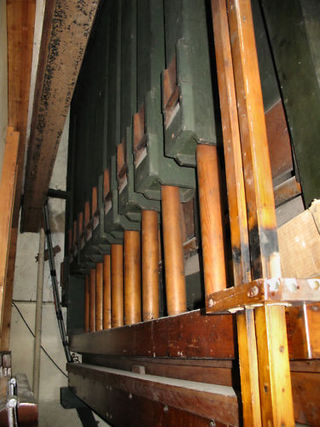Sources
- William H. Barnes The Contemporary American Organ (1959)
Direct electric action is a systems used in pipe organs to control the flow of air (wind) into the organ's pipes when the corresponding keys or pedals are depressed. In direct electric action, the valves beneath the pipes are opened directly by electro-magnet solenoids, while with electro-pneumatic action, the electro-magnet's action admits air into a pneumatic or small bellows which in turn operates the pipe's valve.
Other types of actions used in pipe organs are tracker action, using mechanical linkage of rods and levers, and tubular-pneumatic action which utilizes a change of pressure within lead tubing which connects the key to the valve pneumatic.

The pipe organ is a musical instrument that produces sound by driving pressurized air through the organ pipes selected from a keyboard. Because each pipe produces a single pitch, the pipes are provided in sets called ranks, each of which has a common timbre and volume throughout the keyboard compass. Most organs have many ranks of pipes of differing timbre, pitch, and volume that the player can employ singly or in combination through the use of controls called stops.

A railway air brake is a railway brake power braking system with compressed air as the operating medium. Modern trains rely upon a fail-safe air brake system that is based upon a design patented by George Westinghouse on April 13, 1869. The Westinghouse Air Brake Company was subsequently organized to manufacture and sell Westinghouse's invention. In various forms, it has been nearly universally adopted.

Pneumatics is a branch of engineering that makes use of gas or pressurized air.

The vacuum brake is a braking system employed on trains and introduced in the mid-1860s. A variant, the automatic vacuum brake system, became almost universal in British train equipment and in countries influenced by British practice. Vacuum brakes also enjoyed a brief period of adoption in the United States, primarily on narrow-gauge railroads. Their limitations caused them to be progressively superseded by compressed air systems starting in the United Kingdom from the 1970s onward. The vacuum brake system is now obsolete; it is not in large-scale usage anywhere in the world, other than in South Africa, largely supplanted by air brakes.

A key is a specific part of a musical instrument. The purpose and function of the part in question depend on the instrument.

A theatre organ is a type of pipe organ developed to accompany silent films, from the 1900s to the 1920s.
Mathias Peter Møller, commonly known as M.P. Möller or Moeller, was a prolific pipe-organ builder and businessman. A native of the Danish island of Bornholm, he emigrated to the United States in 1872 and founded the M.P. Moller Pipe Organ Company in Greencastle, Pennsylvania, in 1875. The city of Hagerstown, Maryland, took notice of Möller's early successes and induced him to move his business there in 1881 to help make it a viable business center in Western Maryland. The company remained in business in Hagerstown. until 1992, with hundreds of employees at its peak and a lifetime production of over 12,000 instruments.
Tracker action is a term used in reference to pipe organs and steam calliopes to indicate a mechanical linkage between keys or pedals pressed by the organist and the valve that allows air to flow into pipe(s) of the corresponding note. This is in contrast to "direct electric action" and "electro-pneumatic action", which connect the key to the valve through an electrical link or an electrically assisted pneumatic system respectively, or "tubular-pneumatic action" which utilizes a change of pressure within lead tubing which connects the key to the valve pneumatic.

Robert Hope-Jones was an English musician who is considered to be the inventor of the theatre organ in the early 20th century. He thought that a pipe organ should be able to imitate the instruments of an orchestra, and that the console should be detachable from the organ.
The electro-pneumatic action is a control system by the mean of air pressure for pipe organs, whereby air pressure, controlled by an electric current and operated by the keys of an organ console, opens and closes valves within wind chests, allowing the pipes to speak. This system also allows the console to be physically detached from the organ itself. The only connection was via an electrical cable from the console to the relay, with some early organ consoles utilizing a separate wind supply to operate combination pistons.
The electro-pneumatic brake system on British mainline railway trains was introduced in 1950 and remains the primary braking system for multiple units in service today, although London Transport underground trains had been fitted with EP brakes since the 1920s. The Southern Region of British Railways operated a self-contained fleet of electric multiple units for suburban and middle-distance passenger trains. From 1950, an expansion of the fleet was undertaken and the new build adopted a braking system that was novel in the UK, the electro-pneumatic brake in which compressed air brake operation was controlled electrically by the driver. This was a considerable and successful technical advance, enabling a quicker and more sensitive response to the driver's operation of brake controls.

A hydraulophone is a tonal acoustic musical instrument played by direct physical contact with water where sound is generated or affected hydraulically. The hydraulophone was described and named by Steve Mann in 2005, and patented in 2011. Typically, sound is produced by the same hydraulic fluid in contact with the player's fingers. It has been used as a sensory exploration device for low-vision individuals.
Electronically controlled pneumatic brakes are a type of modern railway braking system which offer improved performance compared to traditional railway air brakes.

Nicholson & Co. Ltd manufactures pipe organs. It was founded in 1841 by John Nicholson. Its work encompasses the creation of new instruments as well as historical restorations, rebuilds and renovations. In 2013, the firm completed the first wholly new instrument in a British cathedral since 1962 at Llandaff Cathedral in Cardiff.
"Tubular-pneumatic action" refers to an apparatus used in many pipe organs built during the late 19th and early 20th centuries. The term "tubular" refers to the extensive use of lead tubing to connect the organ's console to the valves that control the delivery of "wind" to the organ's pipes. Many such organs are extant 100 or more years after their construction.

Oliwa, Gdańsk Archcathedral is a church in Oliwa, Gdańsk, Poland that is dedicated to the Holy Trinity. Also known as the Archcathedral Basilica of the Holy Trinity in Oliwa, Gdańsk.
Henry Bryceson (1775–1870) was an organ builder and pioneer of electric action in England during the 1860s.

Music technology is the study or the use of any device, mechanism, machine or tool by a musician or composer to make or perform music; to compose, notate, playback or record songs or pieces; or to analyze or edit music.

Casavant Frères Ltée. Opus 1841 is a pipe organ built by the famous Casavant Frères of Saint-Hyacinthe, Quebec. The organ was first completed in 1911 as Casavant Brothers - Opus 452 for St. Andrew's Presbyterian Church at 40 Bentinck Street, Sydney, Nova Scotia, Canada. St. Andrew's later became St. Andrew's United Church and is now the Highland Arts Theatre.
Charles Brenton Fisk, also known as Charlie, was an organ builder and a physicist. Fisk was notable for being one of the first modern organ builders to build traditional organs with tracker actions instead of with electro-pneumatic actions. Before his career in organ building, Fisk was involved in the Manhattan Project during World War II. Fisk's transition of career from physics to music was a subject of a lot of media attention. His company C.B. Fisk, have built notable organs such as the Fisk-Nanney organ. He was born in the United States, in Washington D.C., and grew up in Massachusetts. He died in 1983 due to an liver autoimmune condition.